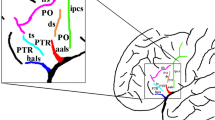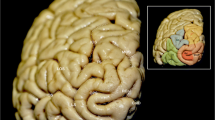Abstract
Purpose
The sulci constituting the structure of the pars triangularis and opercularis, considered as ‘Broca’s area’, present wide anatomical and morphological variations between different hemispheres. The boundaries are described differently from one another in various studies. The aim of this study was to explore the topographical anatomy, confirm the morphological asymmetry and highlight anatomical variations in Broca’s area.
Methods
This study was performed with 100 hemispheres to investigate the presence, continuity, patterns and connections of the sulcal structures that constitute the morphological asymmetry of Broca’s area.
Results
Considerable individual anatomical and morphological variations between the inferior frontal gyrus and related sulcal structures were detected. Rare bilateralism findings supported the morphological asymmetry. The inferior frontal sulcus was identified as a single segment in 54 % of the right and two separate segments in 52 % of the left hemispheres, which was the most common pattern. The diagonal sulcus was present in 48 % of the right and 54 % of the left hemispheres. It was most frequently connected to the ascending ramus on both sides. A ‘V’ shape was observed in 42.5 % of the right hemispheres and a ‘Y’ shape in 38.3 % of the left hemispheres, which was the most common shape of the pars triangularis. Moreover, the full results are specified in detail.
Conclusions
Knowledge of the anatomical variations in this region is indispensable for understanding the functional structure and performing safe surgery. However, most previously published studies have aimed to determine the anatomical asymmetry of the motor speech area without illuminating the topographical anatomy encountered during surgery.








Similar content being viewed by others
References
Albanese E, Merlo A, Albanese A, Gomez E (1989) Anterior speech region. Asymmetry and weight–surface correlation. Arch Neurol 46(3):307–310
Alexander MP, Naeser MA, Palumbo C (1990) Broca’s area aphasias: aphasia after lesions including the frontal operculum. Neurology 40:353–362
Amunts K, Schleicher A, Burgel U, Mohlberg H, Uylings HB, Zilles K (1999) Broca’s region revisited: cytoarchitecture and intersubject variability. J Comp Neurol 412:319–341
Ardila A, Bernal B, Rosselli M (2016) How localized are language brain areas? A review of Brodmann areas involvement in language. Arch Clin Neuropsychol 31:112–122
Ayberk G, Yaglı E, Comert A, Esmer AF, Canturk N, Tekdemir I, Dinc H (2012) Anatomic relationship between the anterior sylvian point and the pars triangularis. Clin Anat 25:429–436
Axer H, Klingner CM, Prescher A (2013) Fiber anatomy of dorsal and ventral language streams. Brain Lang 127:192–204
Benson DF, Ardila A (1996) Aphasia: a clinical perspective. Oxford University Press, New York, pp 127, 135, 168, 169
Benzagmout M, Gatignol P, Duffau H (2007) Resection of World Health Organization Grade II gliomas involving Broca’s area: methodological and functional considerations. Neurosurgery 61(4):741–752
Bernal B, Ardila A, Rosselli M (2015) Broca’s area network in language function: a pooling-data connectivity study. Front Psychol 6:687
Broca P (1861) Nouvelle observation aphémie produite par un lésion de la moité postérieure des deuxième et troisième circonvolutions frontales. Bulletins de la Société Anatomique 6:398–407
Broca P (1861) Remarques sur le siége de la faculté du langage articulé, suivies d’une observatoin d’aphémie (Perte de la Parole). Bulletin de la Société Anatomique de Paris 6:330–357
Dick AS, Bernal B, Tremblay P (2014) The language connectome: new pathways, new concepts. Neuroscientist 20:453–467
Duffau H, Moritz GS, Mandonnet E (2014) A re-examination of neural basis of language processing: proposal of a dynamic hodotopical model from data provided by brain stimulation mapping during picture naming. Brain Lang 131:1–10
Duvernoy H (2006) Atlas of morphology and functional anatomy of the brain. Springer, Berlin, pp 17–121
Falzi G, Perrone P, Vignolo LA (1982) Right–left asymmetry in anterior speech region. Arch Neurol 39(4):239–240
Flinker A, Korzeniewska A, Shestyuk AY, Franaszczuk PJ, Dronkers NF, Knight RT, Crone NE (2015) Redefining the role of Broca’s area in speech. Proc Natl Acad Sci USA 112(9):2871–2875
Foundas AL, Leonard CM, Heilman KM (1995) Morphologic cerebral asymmetries and handedness. The pars triangularis and planum temporale. Arch Neurol 52:501–508
Foundas AL, Leonard CM, Gilmore RL, Fennell EB, Heilman KM (1996) Pars triangularis asymmetry and language dominance. Proc Natl Acad Sci USA 93:719–722
Foundas AL, Eure KF, Luevano LF, Weinberger DR (1998) MRI asymmetries of Broca’s area: the pars triangularis and pars opercularis. Brain Lang 64:282–296
Foundas AL, Bollich AM, Corey DM, Hurley M, Heilman KM (2001) Anomalous anatomy of speech–language areas in adults with persistent developmental stuttering. Neurology 57:207–215
Foundas AL, Weisberg A, Browning CA, Weinberger DR (2001) Morphology of the frontal operculum: a volumetric magnetic resonance imaging study of the pars triangularis. J Neuroimaging 11:153–159
Germann J, Robbins S, Halsband U, Petrides M (2005) Precentral sulcal complex of the human brain: morphology and statistical probability maps. J Comp Neurol 493:334–356
Gil RS, Gatignol P, Capelle L, Mitchell MC, Duffau H (2005) The role of dominant striatum in language: a study using intraoperative electrical stimulations. J Neurol Neurosurg Psychiatry 76(7):940–946
Hagoort P (2006) On Broca, brain and binding. In: Grodzinsky Y, Amunts K (eds) Broca’s region. Oxford University Press, Oxford, pp 242–253
Harasty J, Double KL, Halliday GM, Kril JJ, McRitchie DA (1997) Language-associated cortical regions are proportionally larger in the female brain. Arch Neurol 54:171–176
Keller SS, Highley JR, Garcia-Finana M, Sluming V, Rezaie R, Roberts N (2007) Sulcal variability, stereological measurement and asymmetry of Broca’s area on MR images. J Anat 211:534–555
Keller SS, Crow T, Foundas A, Amunts K, Roberts N (2009) Broca’s area: nomenclature, anatomy, typology and asymmetry. Brain Lang 109:29–48
Knaus TA, Bollich AM, Corey DM, Lemen LC, Foundas AL (2006) Variability in perisylvian brain anatomy in healthy adults. Brain Lang 97:219–232
Knaus TA, Corey DM, Bollich AM, Lemen LC, Foundas AL (2007) Anatomical asymmetries of anterior perisylvian speech–language regions. Cortex 43:499–510
Kononova EP (1949) The frontal region. Architectonics of the cerebral cortex. Medgiz, Moscow, pp 309–343
Lemaire JJ, Golby A, Wells WM III, Pujol S, Tie Y, Rigolo L, Yarmarkovich A, Pieper S, Westin CF, Jolesz F, Kikinis R (2013) Extended Broca’s area in the functional connectome of language in adults: combined cortical and subcortical single-subject analysis using fMRI and DTI tractography. Brain Topogr 26:428–441
Luders E, Narr KL, Thompson PM, Rex DE, Jancke L, Toga AW (2006) Hemispheric asymmetries in cortical thickness. Cereb Cortex 16:1232–1238
Nikkuni S, Yashima Y, Ishige K, Suzuki S, Ohno E, Kumashiro H (1981) Left–right hemispheric asymmetry of cortical speech zones in Japanese brains. No to Shinkei 33(1):77–84
Ono M, Kubik S, Abernathey CD (1990) Atlas of the cerebral sulci. Thieme, New York
Petrides M, Pandya DN (2004) The frontal cortex. The human nervous system. Elsevier Academic Press, San Diego, pp 950–972
Plaza M, Gatignol P, Leroy M, Duffau H (2009) Speaking without Broca’s area after tumor resection. Neurocase 15(4):294–310
Ribas GC (2010) The cerebral sulci and gyri. Neurosurg Focus 28:E2
Tate MC, Herbet G, Moritz GS, Tate JE, Duffau H (2014) Probabilistic map of critical functional regions of the human cerebral cortex: Broca’s area revisited. Brain 137:2773–2782
Tomaiuolo F, MacDonald JD, Caramanos Z (1999) Morphology, morphometry and probability mapping of the pars opercularis of the inferior frontal gyrus: an in vivo MRI analysis. Eur J Neurosci 11:3033–3046
Wada JA, Clarke R, Hamm A (1975) Cerebral hemispheric asymmetry in humans. Cortical speech zones in 100 adults and 100 infant brains. Arch Neurol 32:239–246
Watkins KE, Paus T, Lerch JP, Zijdenbos A, Collins DL, Neelin P, Taylor J, Worsley KJ, Evans AC (2001) Structural asymmetries in the human brain: a voxel-based statistical analysis of 142 MRI scans. Cereb Cortex 11:868–877
Author information
Authors and Affiliations
Corresponding author
Ethics declarations
Conflict of interest
All authors certify that they have no affiliations with or involvement in any organization or entity with any financial interest or non-financial interest in the subject matter or materials discussed in this manuscript.
Rights and permissions
About this article
Cite this article
Eser Ocak, P., Kocaelı, H. Investigation of topographical anatomy of Broca’s area: an anatomic cadaveric study. Surg Radiol Anat 39, 357–365 (2017). https://doi.org/10.1007/s00276-016-1748-0
Received:
Accepted:
Published:
Issue Date:
DOI: https://doi.org/10.1007/s00276-016-1748-0




